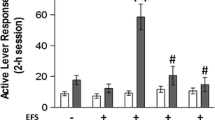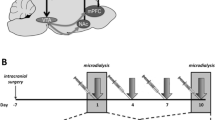Abstract
Rationale
Footshock reinstates cocaine seeking in cocaine-experienced rats by inducing corticotropin-releasing factor (CRF) and glutamate release in the ventral tegmental area (VTA) and thus activating VTA dopaminergic neurons. Footshock-induced VTA glutamate release, dopamine activation and reinstatements are blocked by VTA administration of a α-helical CRF, a nonselective CRF receptor antagonist. The effects of selective CRF antagonists have not yet been reported.
Objective
The present studies were designed to explore the roles of VTA CRF receptor subtypes and CRF-BP in these effects induced by footshock.
Methods
Rats were first trained to lever-press for intravenous cocaine (1 mg/infusion/0.13 ml, FR-1 schedule), and then tested under extinction conditions until response rates returned to the pretraining baseline. Reinstatements, VTA glutamate and dopamine levels [microdialysis with high performance liquid chromatography (HPLC)] were then assessed, under various pharmacological conditions, after mild inescapable footshock.
Results
Footshock-induced reinstatement of cocaine seeking and release of VTA glutamate and dopamine were blocked by selective blockade of VTA CRF2 receptors (CRF2Rs) but not CRF1Rs. VTA perfusion of CRF or CRF2R agonists that have strong affinity for CRF-BP mimicked the effects induced by footshock while CRFR agonists that do not bind CRF-BP were ineffective. CRF6–33, which competes for the CRF binding site on CRF-BP, attenuated the effects of CRF or urocortin I on VTA glutamate and dopamine release and on reinstatement of cocaine seeking.
Conclusions
The present studies revealed a role of VTA CRF-BP and suggest an involvement of CRF2R in the effectiveness of stress in triggering glutamate and dopamine release and cocaine seeking in drug-experienced animals.






Similar content being viewed by others
References
Bale TL, Vale WW (2004) CRF and CRF receptors: role in stress responsivity and other behaviors. Annu Rev Pharmacol Toxicol 44:525–557
Behan DP, De Souza EB, Lowry PJ, Potter E, Sawchenko P, Vale WW (1995) Corticotropin releasing factor (CRF) binding protein: a novel regulator of CRF and related peptides. Front Neuroendocrinol 16:362–382
Behan DP, Grigoriadis DE, Lovenberg T, Chalmers D, Heinrichs S, Liaw C, De Souza EB (1996) Neurobiology of corticotropin releasing factor (CRF) receptors and CRF-binding protein: implications for the treatment of CNS disorders. Mol Psychiatry 1:265–277
Bonci A, Malenka RC (1999) Properties and plasticity of excitatory synapses on dopaminergic and GABAergic cells in the ventral tegmental area. J Neurosci 19:3723–3730
Campbell EA, Linton EA, Wolfe CD, Scraggs PR, Jones MT, Lowry PJ (1987) Plasma corticotropin-releasing hormone concentrations during pregnancy and parturition. J Clin Endocrinol Metab 64:1054–1059
Chan RK, Vale WW, Sawchenko PE (2000) Paradoxical activational effects of a corticotropin-releasing factor-binding protein “ligand inhibitor” in rat brain. Neuroscience 101:115–129
Chen C, Wilcoxen KM, Huang CQ, Xie Y-F, McCarthy JR, Webb TR, Zhu Y-F, Saunders J, Liu X-J, Chen T-K, Bozigian H, Grigoriadis DE (2004) Design of 2,5-dimethyl-3-(6-dimethyl-4-methylpyridin-3-yl)-7-dipropylaminopyrazolo[1,5-a]pyrimidine (NBI 30775/R121919) and structure-activity relationships of a series of potent and orally active corticotropin-releasing factor receptor agonists. J Med Chem 47:4787–4798
Eckart K, Jahn O, Radulovic J, Radulovic M, Blank T, Stiedl O, Brauns O, Tezval H, Zeyda T, Spiess J (2002) Pharmacology and biology of corticotropin-releasing factor (CRF) receptors. Receptors Channels 8:163–177
Erb S, Stewart J (1999) A role for the bed nucleus of the stria terminalis, but not the amygdala, in the effects of corticotropin-releasing factor on stress-induced reinstatement of cocaine seeking. J Neurosci 19:RC35
Erb S, Shaham Y, Stewart J (1998) The role of corticotropin-releasing factor and corticosterone in stress- and cocaine-induced relapse to cocaine seeking in rats. J Neurosci 18:5529–5536
Heinrichs SC, Lapsansky J, Behan DP, Chan RK, Sawchenko PE, Lorang M, Ling N, Vale WW, De Souza EB (1996) Corticotropin-releasing factor-binding protein ligand inhibitor blunts excessive weight gain in genetically obese Zucker rats and rats during nicotine withdrawal. Proc Natl Acad Sci U S A 93:15475–15480
Herringa RJ, Nanda SA, Hsu DT, Roseboom PH, Kalin NH (2004) The effects of acute stress on the regulation of central and basolateral amygdala CRF-binding protein gene expression. Brain Res Mol Brain Res 131:17–25
Huising MO, Flik G (2005) The remarkable conservation of corticotropin-releasing hormone (CRH)-binding protein in the honeybee (Apis mellifera) dates the CRH system to a common ancestor of insects and vertebrates. Endocrinology 146:2165–2170
Jahn O, Tezval H, van Werven L, Eckart K, Spiess J (2004) Three-amino acid motifs of urocortin II and III determine their CRF receptor subtype selectivity. Neuropharmacology 47:233–242
Jahn O, Radulovic J, Stiedl O, Tezval H, Eckart K, Spiess J (2005) Corticotropin-releasing factor binding protein—a ligand trap? Mini Rev Med Chem 5:953–960
Kosten TR, Rounsaville BJ, Kleber HD (1986) A 2.5-year follow-up of depression, life crises, and treatment effects on abstinence among opioid addicts. Arch Gen Psychiatry 43:733–738
Le AD, Harding S, Juzytsch W, Watchus J, Shalev U, Shaham Y (2000) The role of corticotrophin-releasing factor in stress-induced relapse to alcohol-seeking behavior in rats. Psychopharmacology 150:317–324
Linton EA, Wolfe CDA, Behan DP, Lowry PJ (1988) A specific carrier substance for human corticotropiin-releasing factor in late gestational maternal plasma which could mask the ACTH-releasing activity. Clin Endocrinol 28:315–324
Morales MF, Roach E, Diaz-Ruiz O (2005) CRF binding protein in the rat VTA. Soc Neurosci Abstr No. 639.3
Overton PG, Richards CD, Berry MS, Clark D (1999) Long-term potentiation at excitatory amino acid synapses on midbrain dopamine neurons. Neuroreport 10:221–226
Peto CA, Arias C, Vale WW, Sawchenko PE (1999) Ultrastructural localization of the corticotropin-releasing factor-binding protein in rat brain and pituitary. J Comp Neurol 413:241–254
Pollandt S, Liu J, Orozco-Cabal L, Grigoriadis DE, Vale WW, Gallagher JP, Shinnick-Gallagher P (2006) Cocaine withdrawal enhances long-term potentiation induced by corticotropin-releasing factor at central amygdala glutamatergic synapses via CRF1, NMDA receptors and PKA. Eur J Neurosci 24:1733–1743
Saal D, Dong Y, Bonci A, Malenka RC (2003) Drugs of abuse and stress trigger a common synaptic adaptation in dopamine neurons. Neuron 37:577–582
Sarnyai Z, Shaham Y, Heinrichs SC (2001) The role of corticotropin-releasing factor in drug addiction. Pharmacol Rev 53:209–243
Seasholtz AF, Valverde RA, Denver RJ (2002) Corticotropin-releasing hormone-binding protein: biochemistry and function from fishes to mammals. J Endocrinol 175:89–97
Shaham Y, Funk D, Erb S, Brown T, Walker C (1997) Corticotropin-releasing factor, but not corticosterone, is involved in stress-induced relapse to heroin-seeking in rats. J Neurosci 17:2605–2614
Shaham Y, Erb S, Leung S, Buczek Y, Stewart J (1998) CP-154,526, a selective, non-peptide antagonist of the corticotropin-releasing factor1 receptor attenuates stress-induced relapse to drug seeking in cocaine- and heroin-trained rats. Psychopharmacology 137:184–190
Sinha R (2001) How does stress increase risk of drug abuse and relapse? Psychopharmacology 158:343–359
Swanson L, Sawchenko P, Rivier J, Vale W (1983) Organization of bovine corticotropin releasing factor immunoreactive cells and fibers in the rat brain: an immunohistochemical study. Neuroendocrinology 36:165–186
Tagliaferro AP, Morales MF (2005) CRF synapses in the rat ventral tegmental area. Soc Neurosci Abstr No. 872.10
Ungless MA, Whistler JL, Malenka RC, Bonci A (2001) Single cocaine exposure in vivo induces long-term potentiation in dopamine neurons. Nature 411:583–587
Ungless MA, Singh V, Crowder TL, Yaka R, Ron D, Bonci A (2003) Corticotropin-releasing factor requires CRF binding protein to potentiate NMDA receptors via CRF receptor 2 in dopamine neurons. Neuron 39:401–407
Valverde RA, Seasholtz AF, Cortright DN, Denver RJ (2001) Biochemical characterization and expression analysis of the Xenopus laevis corticotropin-releasing hormone binding protein. Mol Cell Endocrinol 173:29–40
Van Pett K, Viau V, Bittencourt JC, Chan RK, Li HY, Arias C, Prins GS, Perrin M, Vale W, Sawchenko PE (2000) Distribution of mRNAs encoding CRF receptors in brain and pituitary of rat and mouse. J Comp Neurol 428:191–212
Wang B, Shaham Y, Zitzman D, Azari S, Wise RA, You ZB (2005) Cocaine experience establishes control of midbrain glutamate and dopamine by corticotropin-releasing factor: a role in stress-induced relapse to drug seeking. J Neurosci 25:5389–5396
Wang J, Fang Q, Liu Z, Lu L (2006) Region-specific effects of brain corticotropin-releasing factor receptor type 1 blockade on footshock-stress- or drug-priming-induced reinstatement of morphine conditioned place preference in rats. Psychopharmacology 185:19–28
Acknowledgement
This work was supported by the intramural research program of NIH (NIDA). We thank Nobuyoshi Suto and Laurel Ecke for suggestions and help with the data collection in the final phases of this study.
Author information
Authors and Affiliations
Corresponding author
Rights and permissions
About this article
Cite this article
Wang, B., You, ZB., Rice, K.C. et al. Stress-induced relapse to cocaine seeking: roles for the CRF2 receptor and CRF-binding protein in the ventral tegmental area of the rat. Psychopharmacology 193, 283–294 (2007). https://doi.org/10.1007/s00213-007-0782-3
Received:
Accepted:
Published:
Issue Date:
DOI: https://doi.org/10.1007/s00213-007-0782-3




